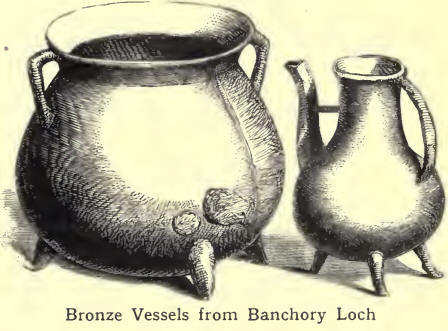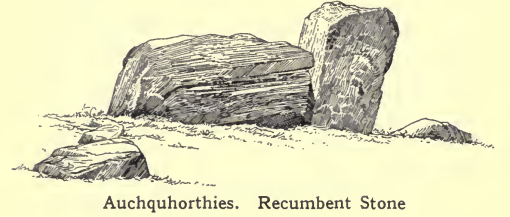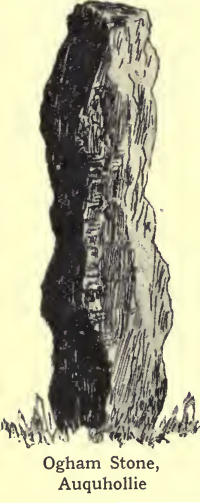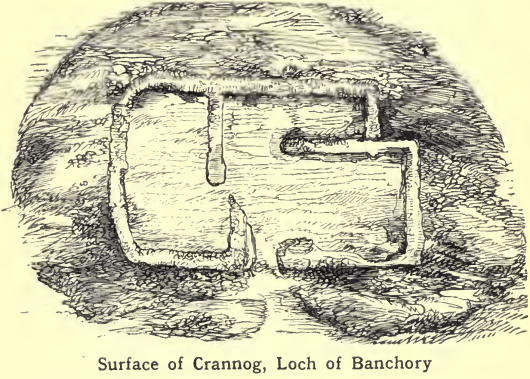The prehistoric period of
man’s existence is divided by archieologists into the Stone Age, the
Bronze Age, and the Iron Age, according to the materials of which
implements of industry or weapons of war were constructed. It must not,
however, be supposed that bronze implements, when first fashioned,
immediately displaced stone implements, or that weapons of iron at once
superseded those in previous use. The different periods overlapped, and
the introduction of the newer and better implements was gradual.

Of the Old Stone Age no
examples have as yet been unearthed in Scotland; but of the Neolithic or
New Stone Age examples are everywhere abundant. Axes, arrow-heads, celts,
knives of flint, whorls, beads, and buttons of jet are among the ancient
treasures found in the county, almost every parish having contributed
its quota.
Specimens of the Bronze Age, which.began probably about 1200 or 1400
years B.C. and lasted for eight or ten centuries, have also been found,
and include spears, hatchets, and other implements. A fine example of a
bronze dagger was unearthed in 1840 near the site of the Roman Camp at
Fordoun, while similar ones have come from Arbuthnott and Kinneff.

Kincardineshire,
especially in the north, has numerous stone circles. Generally the
circles consist of huge blocks of stone, irregular and of unequal size,
some standing erect, others fallen down, arranged in a circle, which
encloses one or even more concentric circles. Sometimes there is in the
circle itself, or in the circumference, a large stone, known from the
way it lies as the recumbent stone. It is usually on the south side of
the circle, and is supposed to have been an altar stone. The
circumference of the circles varies a good deal. The diameter of those
in Banchory-Devenick is from 30 to 100 ft., the largest being the
well-known circle at Auchquhorthies. This one presents some features of
interest. The recumbent stone, 9 ft. 9 ins. long, 5 ft. high, and about
1 foot wide across the top, weighs about io| tons. It lies a
considerable distance from the standing stones. The stones in the
northern arc are small in comparison with the others. The circles are
all composed of the blue granite common to the district, and nearly all
have their recumbent stone on the south or southwest, while in more than
half the circles relics have been found. What these circles were used
for is still a matter of doubt. But since urns and calcined bones have
usually been discovered in them, it is likely that they were burial
places of the Bronze Age.
Other places of sepulture are the mounds or cairns under which have been
found stone cists or coffins containing skeleton remains, along with
urns, cups, beads, rings, arrow-heads, and other relics. In Banchory,
Stra-chan, Marykirk, Kinneff, and elsewhere, these have been discovered,
bearing mute but expressive testimony to the ideas which prehistoric man
had of religion and of a future state.
At Greencairn Castle near Fettercairn are still to be seen traces of
what is supposed to have been a vitrified fort. It was oval in form,
and, like other strongholds of the same character, was surrounded by two
ramparts, built of stone, without any lime or mortar, and without the
least mark of any tool, although under the foundation wood ashes were
got. Evidence of vitrification of the walls was obtained by Sir Walter
Scott in 1796.

Of sculptured stones in
the county the most interesting and most ancient is the Ogham stone at
Auquhollie, near Stonehaven,'one of the fourteen to be found in
Scotland. The writing is in some parts much worn and doubtful, but it
has been deciphered and translated as follows:

“F[a] dh Donan ui te [?
n]
[Here] rests [the body] of Donan, of the race of . . .”
There are three Scottish saints of that name, one being connected with
Aberdeenshire.
When, about sixty years ago, the Loch of Banchory, or Leys, in
Banchory-Ternan, was drained, an island was found to be artificial—a
specimen of the old Celtic lake dwelling or crannog. It rested on trunks
of oak and birch trees laid alternately, the spaces being filled up with
earth and stones, and the island was surrounded with oak piles to
prevent it from being washed away.
There are three interesting examples of old crosses in the county. That
at Fettercairn, the old market cross of Kincardine, surmounts an
octagonal flight of steps, and has an iron rivet to which criminals in
olden days used to be chained by the jougs. The base and shaft of the
old cross of Stonehaven stands beside the steeple (itself a picturesque
Dutch-like erection dating from 1797). In the square of Bervie is a
cross, about 14 ft. high, surrounded by a flight of steps, and supposed
to be of considerable antiquity. The county has numerous holy wells,
none of them of great importance. Two interesting cup-marked stones are
preserved—one at Cowie House, and the other at Dunnottar Manse.
|

